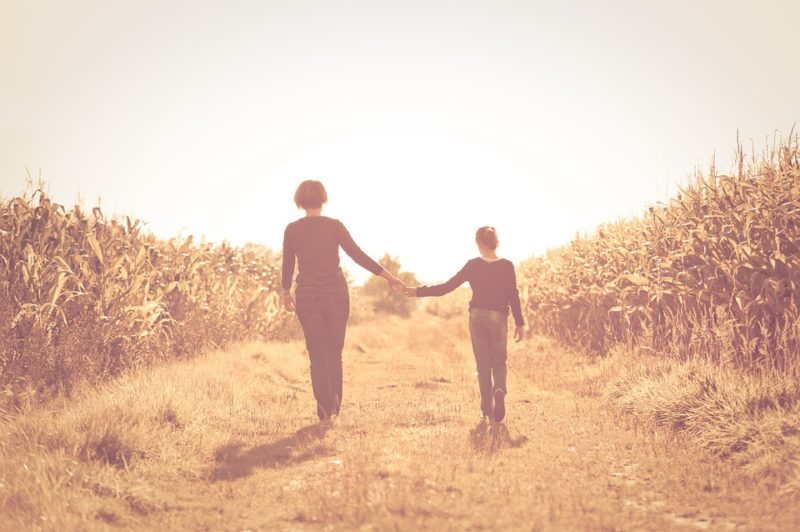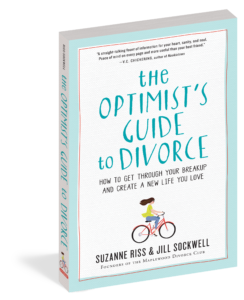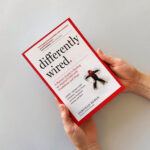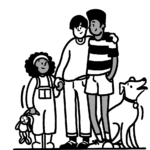By Suzanne Riss, co-author with Jill Sockwell of The Optimist’s Guide to Divorce.

Without a doubt, the single most heartbreaking moment of my divorce was the day I told my six-year-old son that our family would no longer be living together. I went over my speech again and again, but still didn’t feel ready to tell him about the dramatic changes that were about to rock his world. There was no easy way to break the news to him, but I hoped that going to one of our favorite spots by the beach might help. His dad wanted to have his own talk about the separation, so I was on my own.
It was August, and school would be starting soon. My son and I rode our bikes to the point on the New Jersey shore where Shark River forms a bay before it empties into the Atlantic Ocean. We were fascinated as always by the old-fashioned bridge joining Avon-by-the-Sea and the neighboring town as it opened for tall boats. We loved to see the man in the tower descend when a large boat approached. He would close the bridge to cars by pushing a big gate shut; lights would flash and a bell would sound. Then he’d pull a lever to open the bridge, allowing boats to float through to the other side.
Seeing a toddler sitting on the backseat of a bicycle that her mom rode over the bridge reminded me of how much fun I used to have as a child when my own mom used to ride me around town on the back of her bicycle. Feeling a mixture of regret and determination, I told myself that as much as I thought my marriage would last a lifetime, like my parents, I had to accept that this wasn’t the way it worked out. I noticed the seagulls, the surfers, and the lifeguards.
We were enjoying the sun and the sights but I knew I couldn’t put the talk off any longer. “You know, honey, sometimes people who love each other grow apart and can’t agree on things no matter how how hard they try, so they decide to live in separate homes,” I began. I could feel my heart beating. My son stared up at me, his big trusting eyes open wide. “That’s what’s happened for Daddy and me. He’s going to stay in the house, and I’m going to move into an apartment. You’re going to live part of the week with each of us.” I paused. My son wasn’t reacting. Was this registering at all? “You’re the most important part of our lives, and we’re going to take care of you. But Mommy and Daddy aren’t going to be married anymore.”
My son finally spoke. “Okay, Mommy. Can we go in the water now?”
A few days later, he asked whether his dad and I still loved each other. I assured him that we did. And it was true. We still loved each other; we also knew we couldn’t live together. Later, when my son spoke with his dad, it was clear that he had not taken in what was said. He thought I would stay in the house rather than move into an apartment. He wasn’t sure where he was going to live. It took several more conversations for him to sort out what was going to happen.
I received so much advice not only about how to talk to my son but also about how divorce would impact him. Would this trauma shatter him? Would he lose faith in his parents? According to the research I did, I learned that kids generally recover quickly after the initial blow of learning their parents will divorce. Researchers at the University of Virginia found that many children experience short-term negative effects from divorce, especially anxiety, anger, shock, and disbelief. However, these reactions typically lessen or disappear by the end of the second year. In my case, my son eased into the transition within about six months.
What helped the most was to encourage him to express all the different feelings he was having. I let him know that I understood that the changes were hard for him. I reassured him that the constant through the changes was how much his dad and I loved him. Though I wanted to shield him from disappointment and sadness, I knew that wasn’t possible. Instead, I made sure he continued to have plenty of playdates, showered him with love and attention, and helped him focus on his karate classes, because he enjoyed practicing the moves and it gave him a sense of accomplishment.
When school started, I spoke with his teacher, who recommended a family group run by the school social worker for children “in transition,” whether it was due to divorce or another big change. He seemed angry for a few weeks, even hitting a good friend on a playdate. Soon, however, my son started talking about how he was feeling. He said the dinner table was lonely with two people instead of three. If Daddy wasn’t going to live with us anymore, he wanted a dog. We settled on fish first, with the promise of a dog later. I complied when my son asked me to put up a family photo in his room. This photo of him smiling with his dad and I was the steady reminder he wanted that his parents still loved him and each other—and that wasn’t going to change.
 About the Book:
About the Book:
For the more than one million women who get divorced each year, welcome to your support group.
Wise, comforting, and uplifting, The Optimist’s Guide to Divorce captures the experience of sisterhood through the voices of its authors and their community of women in the Maplewood Divorce Club—women who understand what you’re going through, who know the practical issues as well as the emotional ones, and who can help you keep a sense of hope and a sense of humor.
Brimming with stories and insights, valuable resources and smart strategies, in-the-trenches tips and sanity-saving takeaways, this book prepares you for each phase of divorce, from having “the talk,” to breaking the news to family and friends, to figuring out where to live, to co-parenting with an ex, to rebounding and rebooting your life. It’s divided into three sections that cover the process from start to finish—Deal, Heal, and Reveal—and make it easy to jump in wherever you are in your journey. And even better, to make the choices that will help you develop a better relationship with the one person you’ll be with for the rest of your life—yourself.
Buy the Book
Amazon | B&N | Indiebound | Workman





No Comments